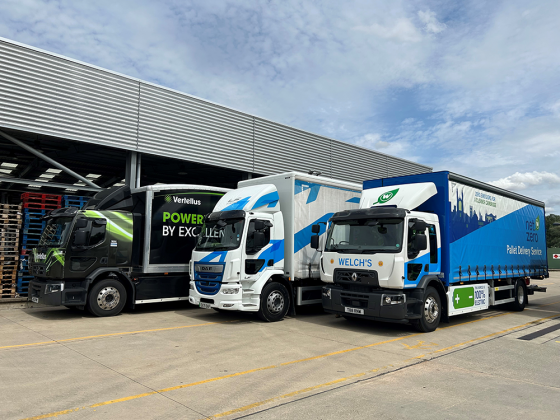Hydrogen: ready for prime time?
Fans who followed the London Olympics last year may have noticed the launch of a fleet of London black cabs specially adapted to run on hydrogen-powered fuel cells to ferry VIPs during the Games. Developed as part of a new EU-funded project, the cabs are just one example of the strides being made across Europe in the development of hydrogen transport and associated infrastructure to create a low-carbon, hydrogen-based economy.
 KEEPING ON TARGET
KEEPING ON TARGET
Adoption of hydrogen-powered vehicles is still in its infancy and there is a great need for national- and European-level support for hydrogen technologies in order to help reduce reliance on fossil fuels. This becomes obvious when Europe’s commitment to reduce CO2 emissions by 80 per cent by 2050 is considered – road transport can account for 95 per cent in CO2 reduction if hydrogen fuel cells can be harnessed aggressively.
2012 also saw the expansion of a network of new fuelling stations and hydrogen-powered vehicle fleets. In addition, major new hydrogen transport ventures were announced that will lead to increasing momentum this year as many European countries including the UK prepare for the arrival of commercially available hydrogen fuel cell vehicles from 2014/15.
Hydrogen represents a viable alternative to conventional fuels and a solution to some of the planet’s most important energy problems, producing zero harmful emissions at the point of use. Though most closely linked with transport vehicles, hydrogen fuel cells are also a cost-effective solution for generating industrial power for energy-intensive, stationary applications such as the chemicals sector. As a result, many companies ranging from small innovators such as Surrey-based AFC Energy to multinationals such as Air Products and Mercedes Benz are investing vast amounts of human and financial capital to harness it for clean energy. For example, Air Products, a global leader in hydrogen technologies, alone has built more than 150 fuelling stations in 19 countries worldwide.
THE NEW ALTERNATIVE FUEL
Green bus fleets powered by hydrogen fuel cells are becoming a familiar sight in big cities in Europe and with the expected launch of hydrogen cars by major manufacturers, the day is not far off when fuel cell vehicles become a hot topic of celebrity gossip just as hybrid vehicles did a few years ago. The key factors contributing to their development are soaring costs of fossil fuels, climate change commitments and the need to clean up our environment and improve air quality.
Fuel cell electric vehicles powered by hydrogen provide the same range, performance and fuelling time as conventional internal combustion engines while producing zero emissions. While it is still early days, which makes estimates prone to a degree of uncertainty, the market for fuel cell vehicles could grow rapidly in the next 20 years.
According to E4tech, the sustainable energy consultants, 1.5 million fuel cell cars alone could be on the road by 2020 and increase to 35 million by the following decade. Taking account of the fleets of buses and light commercial vehicles that are also likely to come into service, the potential size of the market is obviously colossal.
CAR SECTOR
The first hydrogen fuel cell vehicles are set to hit the market by the middle of the decade, with several major car manufacturers developing hydrogen-powered models. At the 2012 World Hydrogen Energy Conference, Daimler AG, Honda, Hyundai and Toyota all confirmed plans to produce hydrogen fuel cell vehicles for sale by 2015, with some types planned to enter the showroom in 2013.
Fuel cell light duty vehicles have so far seen limited use but this is set to change as automakers have targeted 2015 for initial commercial sales of their fuel cell vehicles. Initial locations for this rollout will most likely concentrate around clusters of early hydrogen refuelling infrastructure in Japan, Germany and the USA, and will then spread outwards from these centres as the market is established.
In the UK a £400 million government backed cross-industry trial programme called UKH2Mobility was launched recently to help commercialise and reduce the costs of making fuel cell vehicles. The project brings together three government departments and 13 companies from the utility, gas infrastructure and car manufacturing sectors.
PUBLIC TRANSPORT
The fuel cell bus sector is also gaining traction with more prototypes being unveiled. Successful deployments have taken place in Europe, Japan, Canada and the USA but the high capital cost is still a barrier to widespread adoption. However late last year the EU Commission’s Fuel Cell and Hydrogen Joint Undertaking (FCH-JU) published an encouraging study on hydrogen buses throughout Europe. The project was established to evaluate the feasibility of decarbonising public transport by 95 per cent throughout Europe by 2050.
The performance of hydrogen fuel cell buses was found to be broadly similar to their conventionally fuelled counterparts. The report also highlighted the economic argument in favour of fuel cell buses as the cost of hydrogen fuel compares favourably with conventional fuels. The report concluded that hydrogen fuel cell buses, and other zero-emissions vehicles, are crucial if the EU expects to meet its transport and greenhouse gas emissions reduction targets. The use of hydrogen buses are also cited as playing a key role in addressing the critical issue of air pollution in cities.
The FCH-JU has invited public authorities, transport operators, bus manufacturers, component providers and other interested organisations to partner with them in the next phase of the study, which aims to detail the roadmap towards the implementation of hydrogen fuel cell technology in urban transport in Europe.
Europe’s leading hydrogen bus demonstration project CUTE and its successor HyFLEET: CUTE blazed a trail in proving fuel cell and hydrogen propulsion technologies. The trials were conducted in eight European cities including Amsterdam, London and Hamburg. In HyFLEET: CUTE, 33 fuel cell buses and 14 internal combustion engine buses operated in daily public service. In total the buses accumulated in excess of 2.5 million kilometres and carried more than 8.5 million passengers, proving the reliability of the new technology. The project also demonstrated the next generation fuel cell/battery hybrid bus which has reduced hydrogen consumption by half.
Perhaps the most high profile hydrogen transport project in the UK, the Transport for London hydrogen bus fleet, in 2012 completed a second full year of operation and reached some important milestones. This project formed part of the FCH-JU successor project ‘CHIC’ or ‘Clean Hydrogen in Cities’ in which a further 26 buses produced using the knowledge and experience gained from the CUTE project are currently being demonstrated. A fleet of these buses have been transporting London’s passengers on the busy RV1 route between Covent Garden and Tower Gateway Station and are central to the city’s efforts in reducing CO2 emissions. The fleet is refuelled at Air Products’ Stratford fuelling station where well over 1,000 fuellings have enabled the buses to travel 100,000 miles around the capital. One full tank of hydrogen enables a bus to travel for up to 18 hours, and the buses emit no carbon emissions – only water vapour.
A brand new hydrogen bus fleet was announced for Scotland recently. Backed by funding from the Scottish Government, Aberdeen City Council is planning to order 10 hydrogen fuel cell buses, which they expect to be running from 2014. The project will also mean the installation of a new fuelling station in Aberdeen and an effort to generate renewable hydrogen from wind energy.
AN OLYMPIC TEST
London is increasingly becoming a hydrogen transport hub and a new project was delivered in the capital to coincide with the Olympic and Paralympic Games. The fleet of hydrogen fuel cell powered taxis provided by the HyTEC (Hydrogen Transport for European Cities) consortium travelled 2,500 miles around London during the Olympics fuelled by the capital’s second hydrogen fuelling station installed at Heathrow airport.
The pioneering fleet of fuel cell electric London taxis, which were developed by the UK power technology company Intelligent Energy and The London Taxi Company, transported 132 visiting dignitaries and the VIP guests of the Greater London Authority during the Olympic and Paralympic period. This was the first phase of the HyTEC project, which will continue for the next three years and will also install a network of fuelling stations in Copenhagen, Denmark.
LOOKING TO 2014/15
2013 is going to see major new projects as the hydrogen transport industry seeks to ready itself for the arrival of commercially available hydrogen fuel cell vehicles. With major car companies committed to having hydrogen fuel cell vehicles on the forecourts of car dealerships by 2014/15, hydrogen infrastructure companies have a clear target to work towards.
One of the main requirements is 700 bar fuelling stations, up from the original 350 bar pressure. The latest hydrogen fuelled vehicles are able to store hydrogen in their tanks at this higher pressure, allowing them to achieve a greater range of travel between refuelling.
Across the Channel, the Hydrogen Infrastructure for Transport (HIT) project recently received the green light for the roll-out of a network hydrogen refuelling stations along a first 1000km corridor from Gothenburg to Rotterdam and to demonstrate state-of-the-art refuelling technology through the construction of three pilot stations in the Netherlands and Denmark.
GOING THE DISTANCE
A strong selling point to use hydrogen as an energy carrier for long distance transport is that it is a perfect range extender for electric vehicles. The ambition of HIT is to kick-off an EU network of refuelling stations to facilitate clean and sustainable transport along the main transport axis in Europe, thereby turning these into Green corridors.
While the impact of a functioning hydrogen economy on the environment would be hard to overstate, major economic benefits are also likely if the transition from fossil fuels is helped with fiscal incentives. A recent survey and analysis by the UK Hydrogen and Fuel Cell Association (UKHFCA) and the Energy Generation and Supply Knowledge Transfer Network found that the sector has the potential to become a low carbon success story by delivering more than 2,200 new jobs in the UK, preserve approximately 145,000 jobs in automotive manufacturing and generate £1bn annual revenues by 2020. To help make this happen, the UKHFCA is calling on the government to introduce a feed-in tariff to support fuel cells across the transport, heat and power sectors. In transport, we envisage support in the form of a rebate paid per mile equivalent to the fuel duty paid per mile by a similar conventional vehicle. Such an approach would help drive the hydrogen industry to establish the infrastructure for the mobility sector to fulfil its potential. It is a prize worth chasing.
FOR MORE INFORMATION
www.h2euro.org






